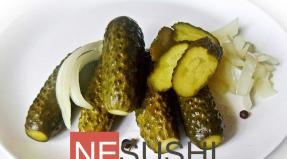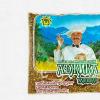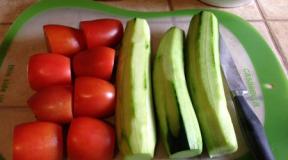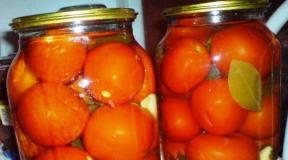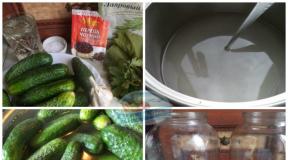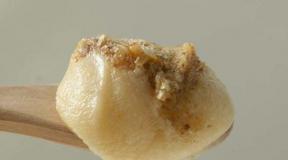This butter should be soft. Slippery theme
Bread and butter - it is for them that millions of Russians eat and have a snack. We fry in butter, we bake pies with it, it is in every fridge. But is it butter?
"Vologda" is no more
According to the data of the Russian Union of Dairy Enterprises, butter takes the second place in the country after alcoholic production in terms of falsification. By law, this product must contain exclusively dairy ingredients - but what does it really consist of?
Entrepreneurial manufacturers replace milk fat with cheap palm kernel oil. It does not contain valuable nutrients, trace elements and vitamins inherent in the natural product obtained from the cow. Moreover, vegetable fat contains trans fatty acid isomers, causing pathological changes in the body.
At the same time on the packaging they write that the product is made according to GOST, that the oil is “Vologda”, and other consumer-encouraging words. After all, not every buyer knows that “Vologda” is no longer the name of the variety, now any manufacturer working in the Vologda region can call it so.
In Europe, oil requirements are more stringent than ours, ”says Roman GAYDASHOV, an expert of the society for the protection of consumer rights “Public Control”. - They do not approve not only the components that replace cow fat, but even pasteurisation flavors, cream, and various odors. Our state guarantees the consumer some kind of security, that is, it protects against radionuclides and other terrible substances, but does not ensure the quality of the product. This leads to the fact that instead of butter, we eat a creamy vegetable spread.
Back to the 90s
The examination carried out by the Moscow Quality State Unitary Enterprise in the Test-Pushchino testing laboratory showed that of the five samples of butter, only two corresponded to the information on the label, the requirements of GOST and the Technical Regulations for dairy products (see table). The majority of the fat-acid composition did not meet the requirements of the law, in other words - the manufacturer did not use animal but vegetable fats. In one of the samples, E. coli was found, not to mention the forbidden preservatives and foreign flavors.
This splash of rigging butter was observed only in the early 90s. It seemed that we had successfully survived this moment, - complains Igor NAZAROV, Deputy General Director, Moscow Quality State Unitary Enterprise.
It turns out they did not survive. Is that the choice has become more. Today on the Moscow shelves you can find about 80 different types of butter. More than 60% - Russian production. Price range - from 30 to 140 rubles. Imported (France, Finland, New Zealand) is more expensive, but, as practice shows (including the latest expertise), it is more qualitative.
Abroad, they love more sour-cream oil, ”says R. Gaidashov. - It contains lactic acid concentrate and is considered more useful. But our consumer has a taste of sweet cream varieties for the production of which only pasteurized cream is used.
By the way, importing companies do not always bring packaging into line with Russian legislation - they do not indicate the category of oil or write a grade (for example, “Extra”), which we don’t have. Therefore, by the form of a sealed pack it is extremely difficult to understand what is inside.
Try to find a good butter by experience. Here are a few signs of a quality product:
At a price of 30 rubles. only spread can be sold;
High-quality butter does not freeze even in the freezer, it always remains plastic and after 5 minutes should be easily spread on bread;
The color of a good oil is from whitish to light yellow, a bright yellow shade is a bad sign;
The oil should not crumble at the fracture (if this happens, then it contains a large amount of moisture).
|
The results of the examination of the State Unitary Enterprise "Moscow quality" and the laboratory "Test-Pushchino" * |
||||||||||
|
Butter, |
According to |
Bulk |
Mass fraction |
The fatty-fat composition of milk fat |
Micro- |
Conse rwanty |
According to |
|||
|
in accordance with GOST |
actual content |
in accordance with GOST |
declared |
actual content |
||||||
|
Butter |
18,5- |
80-85 |
82,5 |
84,9 |
corresponds to milk fat |
not revealed |
according to |
|||
|
Butter |
15,8 |
82,5 |
82,5 |
82,9 |
not |
not revealed |
does not correspond |
|||
|
Butter |
25,4 |
82,5 |
82,5 |
not |
out |
159,5 |
do not match on microbial |
|||
|
Butter |
14,3 |
82,5 |
82,5 |
84,1 |
not |
not |
do not match on organo- |
|||
|
Resident, |
14,0- |
15,4 |
50,0- |
82,7 |
acc. milk fat |
not |
corresponding |
|||
|
* The oil was examined for compliance with the requirements of the Federal Law from |
||||||||||
In the section on the question. Does real butter without additives need to be frozen in the fridge or not? specified by the author Shoko-okay the best answer is This oil freezes, but it does not turn into a stone, and when you start cutting it right after you get it out of the refrigerator it does not crack and the knife goes smoothly.
If it stays warm for a long time, nothing in any way stands out from it and it does not lose its shape.
But also Valio for example is not a real butter, as it cracks and crumbles when it is cut.
Answer from Vasya[guru]
Of course it should, because it is made of cream.
Answer from Insufficient salting[guru]
No no. This (good) just should not freeze very much.
And when you get out of the fridge, it should quickly melt.
Compare “Vologda” butter and “Ankor” (I don’t consider it as a butter at all)
"Anchor" in general can not be removed in the cold and it will always be solid.
Compare butter and margarine. Margarine is much harder than butter, because it contains additives.
Answer from Simplest[guru]
must necessarily !!
Answer from Neurosis[guru]
the present should not freeze, and that which does not freeze is very harmful, its melting point is higher than the body temperature, it means it does not split in the body, does not provide nutrients, and the gastric juice (hydrochloric acid) does not dissolve it! that's for sure!!
Answer from Evgenia Frenkel[guru]
The melting point of pure milk fat, which forms the basis of butter, has a melting point of 26 ... 32 degrees, that is, it should freeze in the refrigerator but remain plastic: it is easy to smear on bread, to melt on the tongue. If it remains too liquid, or vice versa, it crumbles, it is too solid - this is falsification, fake. There are too many of them now.
Answer from Nastena[guru]
Must! If it does not freeze, then this is a spread!
Answer from Ivan Mornov[guru]
there is a creamy spread, which at room temperature is NOT hidden!
Answer from Dans[active]
Not a very clear question, in the refrigerator the temperature is +5 in the freezer -12. Liquid like water freezes at 0, -1 Old refrigerators do not understand at what temperature freeze.
Answer from Alexey Gumensky[newbie]
Harden - must freeze - no!
It is very fashionable now to talk about natural products, products without GMOs and palm oil - makes life. I also belong to those who look at the composition of products and study it before buying something in the market. Choose the most natural product is very difficult. But even after the purchase, it is not a fact that the manufacturer has faithfully written the composition and the product will be of good quality.
However, you can check the purchased product (in our case, butter, sunflower and olive) at home, so that the choice next time was easier.
Butter 
The best butter that you made yourself from natural milk. Purchase oil can be checked only at home:
1. Send the oil in the freezer for 3-4 hours. We take it out of the refrigerator and cut it with a knife into pieces. If the oil crumbles into pieces, the oil is natural (or as close to natural as possible), if it is cut easily, leaving traces on the knife, there is a large amount of vegetable oil (possibly palm oil) in it.
2. Throw a piece of butter in a dry frying pan and fry. If foam is visible along the edges of the oil, and the oil has a pleasant milky smell, the oil is of good quality.

3. In a large spoon, throw a piece of butter and heat over an open fire (for example, over a gas stove). If in oil, after boiling lumps are visible - it is highly likely that it is natural, if a simple yellow liquid is butter with the addition of vegetable oil.
Olive oil

One of the properties of olive oil is its quick freezing. Therefore, the fastest way, which will inform you about the quality, undiluted oil, will be its freezing. After 15-20 minutes, high-quality olive oil in the refrigerator (freezer) should turn cloudy (from the cold) and begin to settle down with cooled parts-flakes in the sediment.
Diluted with other (cheaper oil or palm) olive oil will not freeze, being in the refrigerator for 15 minutes.
Sunflower oil

It is very difficult to find high-quality sunflower oil. Before you buy it in the store, you need to see if it is cloudy, if it contains sediment.
Remember:
1. The shelf life of refined sunflower oil is not more than 12 months.
2. The shelf life of non-refined oil - no more than 5 months.
3. On the bottle, the manufacturer writes the term of the spill of sunflower oil, and not the term of its manufacture. You can buy already rancid oil, which the manufacturer poured just a couple of days ago.
Be careful with shopping and take care of your health!
And how do you check the naturalness of the products?
To get the best articles, subscribe to Alimero's pages.
Why does butter not freeze in the fridge, remains soft?
Most likely you really do not buy butter, but some kind of fake for it. The oil that I buy even when lying in the fridge freezes so that, before smearing it on bread, I have to warm it up a little in the microwave. And even in childhood, butter from the refrigerator did not smear on bread either, and we heated it over a glass with hot tea.
I take out of the freezer and nails they hammer! In the refrigerator, the oil is soft, as it should be. Apparently the wrong kind of bertha, I bought one brand from New Zealand for a long time, now one more of ours began to buy!
if it is written on the pack that the oil creamyquot ;, it must be hardened in the refrigerator. when the grandmother kept the cow, her own oil even in the cellar was hard. and in the fridge, it wasn’t really cut off at all. if the butter is soft all the time, it means that vegetable fat has been added there, and on the package of such oil should be written creamy vegetable
Butter does not freeze in the refrigerator, because it contains milk fat, which in the oil can be from 72% or more, depending on the type of butter. Exactly this fat does not allow the oil to harden, as for example the fat in the refrigerator does not harden. But still, if you put the butter in the freezer, it will harden, and it will have to be peeled off with pieces like ice floe.
I buy butter on the market from thrush. And you know what is its main difference from the oil with different herbal supplements? 100% butter should freeze in the freezer and when trying to cut it, peel off the slices.
It does not freeze in the mill-pot not a natural butter, but a parody of it. Due to the fact that in a product called butter they stuffed everything they could - different oils that should not be included in the composition at all, and the recipe was broken.
Vologda butter does not harden in the refrigerator - apparently due to the specificity of the manufacturing technology
then the butter that does not freeze is not butter at all, but it doesn’t freeze butter to the races and, if you remove it from the refrigerator, you will not smear it so easily
Most likely this is not a real butter, but a spread. This is a vegetable oil or butter with the addition of vegetable fats. Sometimes manufacturers may not specify in the composition of vegetable fats.
if you have a fridge that freezes well, then the answer is one:
with this non-freezing oil " not quite ok:
in nm there are additives of vegetable oils ...
and other additives ..
those. According to modern classification, it is not butter, but spread.
in general, the thing is not natural and not useful ...
Probably every hostess has ever come across such a situation: a sandwich hopelessly spoiled by the “butter” from a freshly opened packet. It is summer, in stores, the products sold when improperly stored spoils quickly. Especially when it comes to perishable foods, the categories of which include butter. tells how to choose butter and how to determine its quality at home. Let's see what should be this natural product of dairy production.
Sun oil
Butter is in high consumer demand in our country. What is not surprising, this product is on our table every day. Everybody knows the saying: “You will not spoil porridge with butter” quite justifies itself. What kind of porridge, if it is not seasoned with butter, what kind of sandwich without it, it is an indispensable ingredient in many recipes when preparing dough, various creams, as a great addition to some soups. 
Butter is a very useful product of dairy production, it is rich in vitamins A, E and K, contains proteins and carbohydrates, milk fat, minerals (potassium, calcium, magnesium, iron, phosphorus, sodium, copper, zinc, manganese). That is, almost all the beneficial substances found in cow's milk are also found in butter, as it is made by separating or churning cream collected from cow's milk. That is why nutritionists recommend daily to include this product that is valuable for human health in your diet.
Of course, it is necessary to eat butter moderately, since it is a high-calorie product (748 kcal per 100 g), which is easily absorbed by the body (by 91%). In addition, butter contains a rather high percentage of cholesterol (200 mg per 100 g of the product, with a tolerable rate of 300 mg). As it is known, an increase in the level leads to the development of heart problems, negatively affects the vessels of a person. 
The recommended rate without harm to health is 10 - 20 g of butter per day. That is, you can put a piece of butter in the porridge, which you cooked yourself on or spread a couple of sandwiches (but not with sausage, but, for example, with cheese). Such a number will not cause damage to your figure, but will bring great benefits to health and beauty. Especially oil is useful to eat in the cold season of the year, it will give your body extra energy.
Rules for buying butter in the store
Going to the store it is important to buy a high-quality, natural product that carries all the benefits to the body. How to choose butter correctly? What you need to pay attention to first?
1. Name. The package should contain, for example, “peasant oil” or “traditional oil”, etc. If the word “OIL” is not written on the package, then according to the law, this product is no longer butter, but is a kind of analogue, but simply a surrogate or spread. Spread is just a fatty product made from vegetable fats. The percentage of milk fat in them is less than in natural butter, or it may not be at all (then it is pure margarine). Should you take a cheap and low-quality product, of course you decide. But there is no use in such a product, most likely only harm. 
2. Fat. In this butter, the percentage of fat should be at least 72.5%. It is the milk fat of cow's milk contained in the natural product has the most useful and nutritional properties.
Butter, in accordance with the content of the percentage of milk fat, in Russia is divided into:
- traditional, it has the largest percentage of fat mass fraction - 82.5%;
- amateur, also has a high percentage of the mass fraction of fat - 80.0%;
- peasant, the percentage of fat mass fraction is 72.5%;
- sandwich with a percentage of fat mass fraction - 61.0%;
- tea, has the smallest percentage of the mass fraction of fat - 50.0%.
If you see a package with the name “sandwich butter”, then you need to understand that having only 61% fat content, this product can no longer be a real butter. Therefore, the sandwich and tea oil contain, in addition to milk fat: flavors, food colors, emulsifiers, texture stabilizers.
In addition to the product name itself, you can still read the inscription: sweet and sour, which means that the butter was made from fresh (sweet) pasteurized cream. If, in addition to the word butter, a “sour cream” is also written on the pack, it means that the oil is also made from pasteurized cream but using sour-milk cultures (it is allowed to add leaven to such butter). Sour butter is considered more useful because it is produced using lactic acid microorganisms, and it also has a more pleasant taste.
Another oil (traditional, amateur, peasant) is divided into salty and unsalted, which can also tell you the label. 
3. GOST. It is necessary to choose butter on which GOST 37-91, first or highest grade is specified (this is the main GOST, there are also other GOSTs which do not cancel the requirements of the main one, but expand the assortment names). Be careful: the spread according to the law of the Russian Federation, issued in 2004, can now be specified GOST R 52100-2003. That is why you need to be especially careful when choosing, because on the packages with natural oil is also GOST. Such a low-grade product was produced, in order to sell it, write slogans calling for action: “light”, “diet”, “natural aroma”, “creamy taste”. As you understand, both the taste and the fabulous aroma of such a product can be due to only one thing - the presence of synthetic flavors and flavorings in it.
Only butter produced according to GOST 37-91 contains everything you need, the difference between butter and vitamins, as well as natural milk fat. These important components help our vision, beauty of skin, hair, nails.
Gostovskoe butter is of two types: first or top grade. The highest quality oil is considered the highest grade. At the same time, experts evaluate organoleptic indicators such as: smell, color, taste, texture, packaging, etc. The product is rated on a 20-point scale. If the butter of this manufacturer as a result of such an assessment gains 11-16 points, then it is assigned the first grade. Upon receipt of 17-20 points - the highest grade.
In addition to the variety, an important indicator characterizing butter is the percentage of fat content. In a natural product, as mentioned above, it cannot be lower than 72.5%.
Butter can also be made according to specifications, in this case it is necessary to carefully examine the composition on the label. 
4. Composition. As part of this butter should be written: cream and whole milk. This means that in a natural product there can be no vegetable fats that are present in spreads. Spreads are of two types: vegetable and creamy, this is when the content of vegetable fats over dairy prevails in them. Conversely, cream-vegetable, in this case, milk fat over vegetable fats prevails in the product. The name of the spread in English means smearing or stretching, i.e. soft butter. Due to the content of vegetable fats in them (and their share is at least 39%), the spread is easily spread, even when cooled in the refrigerator. Despite the fact that spreads can be enriched with various vitamins, phytosterols and other beneficial substances, they are less fatty than butter, but the presence of vegetable fats in them cannot make this product beneficial to health. In addition, they can add flavor enhancers, artificial flavors. The most alarming factor is that all spreads contain trans-isomers of fatty acids, which can cause the risk of developing tumors, diseases of the cardiovascular system, infertility, Alzheimer's disease. Is it necessary to risk so, using the spread instead of the natural product, of course you decide, since no one will be more responsible for their health than you.
5. Price. Butter should have a price of less than 80 - 100 rubles per pack. This is an average figure, a pack can also be of different weights - less than 200 grams. But you need to understand that with the purchase price of milk 20-23 rubles, in order to produce 1 kg of butter, you need to process more than 20 liters of milk. Therefore, real butter cannot be cheap.
6. Date of manufacture. It would be good to look at the date of manufacture, if the price of a pack of oil is suspiciously low. Stores often hold promotions at the end of a product’s shelf life, reducing its price. In this case, it is doubtful to talk about the quality of the product, because by the end of its shelf life, it is already beginning to accumulate harmful substances, oxidation products, and if the proper rules for storage in the store are not followed - harmful microorganisms. The longer the butter was kept in the store, the more likely it is to buy a low-quality product.
The shelf life indicated on the packaging may vary from 1 month to several months. GOST clearly prescribed shelf life - 30-35 days. But on the packaging of imported oil can be seen a much longer period. Such a deviation from the standard is allowed if the manufacturer receives the appropriate permission of Rospotrebnadzor. However, in this case there is a high probability that there are additives that are not useful to human health in order to increase the term. Personally, I buy oil from domestic producers with a monthly shelf life.
7. Packaging. In the store, you should choose butter that is packaged in foil or opaque parchment, then the product will be less susceptible to destruction by light, and hence to oxidation. The packaging should not be deformed, if this is observed, then the oil is most likely thawed and re-frozen, which will adversely affect its quality.
What else can you pay attention to?
8. Hardness test. Try to put a finger on a pack of butter. If it is solid, then this is a good sign. Since the oil containing vegetable fats (palm, coke, rapeseed, sunflower oil) can not completely freeze even in the freezer.
9. Test on the next In addition to hardness, you can also check whether the butter leaves traces. It is necessary to bend the edge of the package and see if there are any traces of oil on it. Natural cream little has a big fat content and can not leave marks on the foil or other packaging in which it is located.
Examination at home: how to determine the quality of butter
Even if you were able to choose the right butter in the store, according to the above points, there is no guarantee that you bought a quality product. Cases of detection in the sale of low-quality dairy products, unfortunately, not uncommon in our time. If you still doubt whether you brought home a real butter, there are "home" ways to check. So, how to determine the quality of butter at home? 
Having opened a pack of butter, housewives quite often can detect a patina of dark yellow color on it. This is due to long storage, the oil is covered with a staff and its surface becomes dark yellow in color. This is not considered a defect of the product, the staff can be easily removed with a knife. The oil itself should not be too yellow or too white in color. If the color of butter is saturated yellow, this can only speak of one thing; a large amount of food coloring, beta-carotene, has been added to it.
But it happens otherwise, if the butter was stored in the store incorrectly - at a temperature above + 4 ° C or in the light, then damage to the product is inevitable. Under the influence of oxygen, the oxidation of fats that make up butter is formed; harmful chemical compounds are formed: aldehydes, ketones, keto acids.
The same can happen if the necessary storage conditions for this product are observed, but with violation of its shelf life. After the expiry of the sale of oil, oxidation processes will inevitably begin, leading to the accumulation in it of substances harmful to the human body. That is why it is important for buyers to look carefully not only at the fat content of this product (for a high-quality oil, this indicator should not be less than 72.5%). But also on the expiration date - is it not close to the end of the implementation period? Especially you need to be careful when the store holds promotions at a discount on butter, in this case, the price reduction may be due to this factor.
High quality oil:
- whitish or light yellow;
- the surface of the cut should be shiny, dry;
- the taste and smell are clean, characteristic of this product.
How to check at home falsification
The most common way to falsify oil is to add hydrogenated vegetable fats to it or to replace the product completely. Unfortunately, to determine their presence in butter at home will have to rely on their own sense of smell and taste. Since only laboratory analysis is able to determine the exact composition of the purchased product. There are other ways of falsification: cottage cheese or cheese is mixed into the butter.
However, at home, you can also try to determine the quality of butter, if you are in doubt. 
1 way. The easiest is to taste it. Take a small piece and try to taste it, as already stated above, the taste should be clean - with a gentle sweet-milky flavor. It should not contain a taste of bitterness, fish, or be too salty (an exception is salted butter, which is specially added salt, thereby increasing its shelf life). Real butter is also almost odorless and quickly melts in the mouth, unlike the spread.
2 way. Dispense a tablespoon of oil in a glass of hot water. When it melts completely, stir the liquid and allow it to settle. Pure butter should not leave a residue, it should be evenly stirred, and not disintegrate into "components".
3 way. Put a piece of butter in the freezer for an hour, this time is enough for hardening, if it is made of cream. Try cutting a frozen piece with a knife, if it starts to crumble into pieces (and not cut with a knife), while the chipping surface is clean and monotonous, then the product is really natural in front of you, without any additives. In the falsified vegetable fats do not allow the oil to harden completely, even in the freezer, it will still be soft and easy to cut with a knife.
4 way. Heat the pan, put a piece of butter in it. It will heat up, begin to melt, a foam will appear, pleasantly smelling. The spread will melt either with an unpleasant smell, or no odor at all.

However, it is not recommended to fry anything in butter, since harmful carcinogens are formed in it when it is heated up. For frying, it is better to use olive or refined sunflower oil.
5 way. If you accidentally forgot to put the oil in the fridge and moisture has come out on its surface in the form of water droplets - such oil cannot be real. In such a case, natural butter slightly undermines, becomes plastic, it can be easily spread on a piece of bread.
Now you know how to determine the quality of butter at home.
Oil belong to the category of perishable products. Therefore, having found that you have purchased a substandard product, do not hesitate to return the store: even with a check after a day, it will be difficult for you to prove that the product was damaged not due to improper storage at home.
I propose to watch the video from the “Test Purchase” program series from which you will learn how to choose butter, the manufacturer of which traditional butter was recognized as the best, and also see how delicious it is to make chicken Kiev and chicken meatballs.
How to store butter
And at the very end there are some tips on how to properly store butter, which has a short shelf life. Everyone of course knows that this perishable product should be stored in. However, acquiring it for a long time, it is better to put it in the freezer so that it does not deteriorate. If for several days, put it in a plastic container with a lid, porcelain or glass oiler. Keep the butter, like all dairy products that are perishable, is best on the top shelf of the refrigerator - where the temperature is lowest. Although in some models of refrigerators such a shelf is located, on the contrary, below. The oil must be closed with a lid or placed in a plastic bag, otherwise it will quickly absorb foreign odors.
